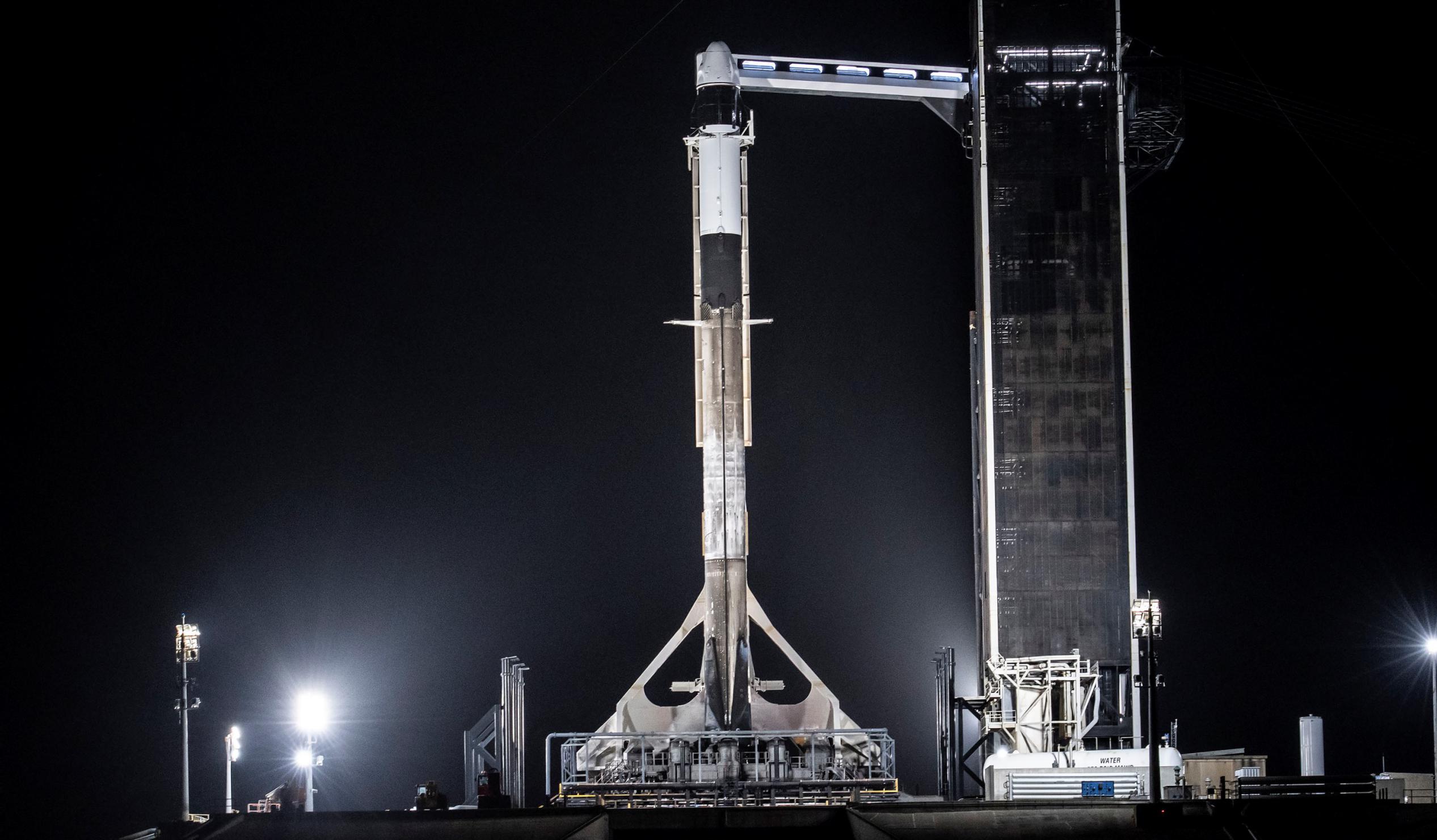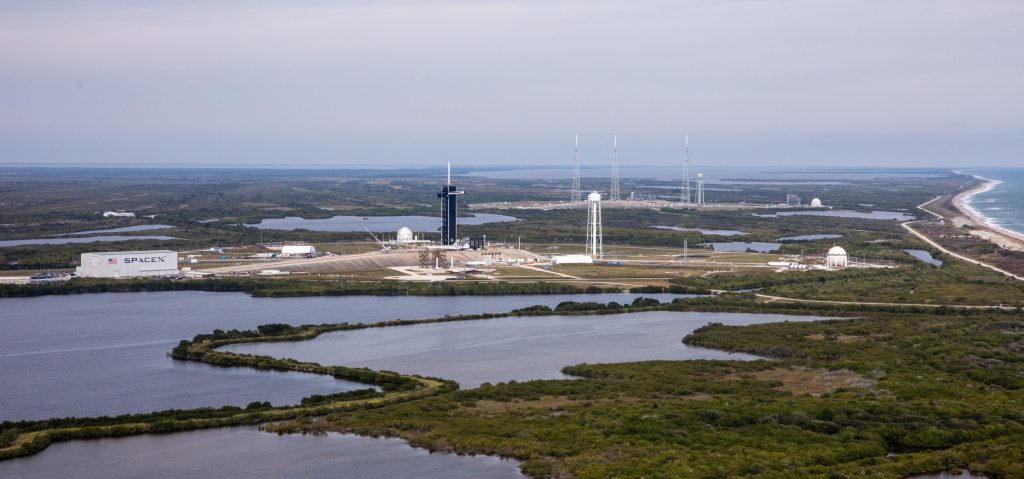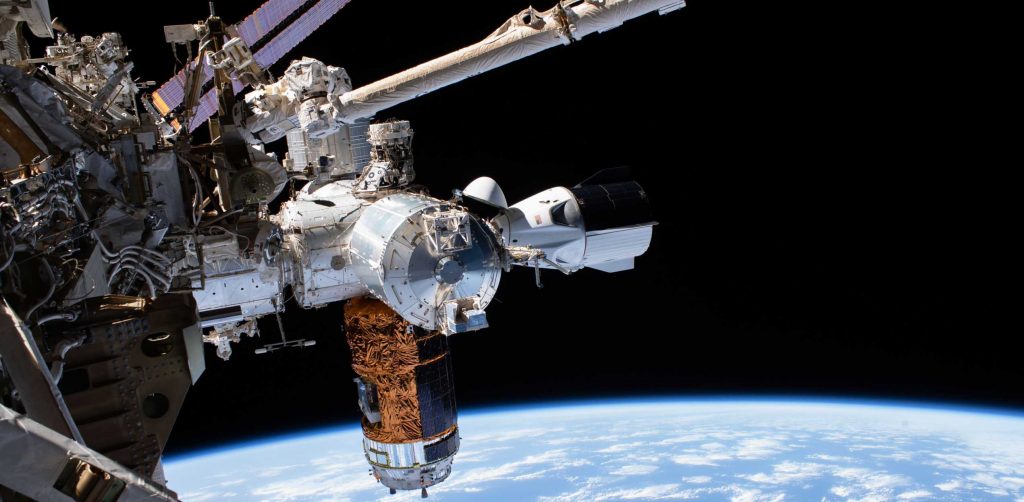

News
SpaceX set for first private astronaut launch to the International Space Station
Update: SpaceX has successfully fired up Falcon 9 booster B1062 and confirmed that Crew Dragon’s second private astronaut launch is on track to lift off at 11:17 am EDT (15:17 UTC) on Friday, April 8th. SpaceX’s live coverage will begin about three hours prior.
A flight-proven Falcon 9 rocket and Crew Dragon spacecraft have rolled out of SpaceX’s Kennedy Space Center (KSC) Pad 39A hangar and been raised vertical ahead of the company’s second private astronaut launch.
Known as Axiom-1 or Ax-1, the mission – managed by third-party provider Axiom Space – aims to be the first fully private crewed launch to the International Space Station (ISS). That means that Ax-1 will launch a crew of private astronauts from a privately-operated launch site with a privately-owned rocket and spacecraft, all with zero direct government impetus or funding. Of course, the situation is a bit more complex just beneath the surface.
The focus of Axiom-1’s crew is three ultrawealthy customers:
- Larry Connor: Ax-1’s pilot and an entrepreneur who accrued his wealth through real estate
- Eytan Stibbe: a venture capitalist and former fighter pilot who could become the second Israeli astronaut ever
- Mark Pathy: CEO of Canadian investment and shipping companies
Each paying $55 million for the ten-day journey and eight-day stay at the International Space Station (ISS), Connor, Stibbe, and Pathy are bankrolling the mission. Crew Dragon’s fourth Ax-1 passenger, however, is Michael López-Alegría, a retired four-time NASA astronaut turned private (space) pilot who now works for Axiom Space.
Launch Complex 39A was originally built and operated by NASA from the 1960s to 2011 before it was leased to SpaceX in 2014. The development of the first versions of SpaceX’s Falcon 9 rocket and Dragon spacecraft were heavily funded by NASA in the late 2000s. After SpaceX won a competitive $3.1 billion contract alongside Boeing, which received $4.8 billion to achieve the same goals, NASA has almost exclusively funded Crew Dragon’s development and is (for now) its main customer. Finally, alongside Russia’s space agency, NASA has invested tens of billions of dollars to build, launch, assemble, crew and maintain the International Space Station for around three decades.


Calling Ax-1 “fully private” is thus more of a half-truth than the full reality. Nonetheless, the fact that SpaceX has significantly benefitted from NASA funding and resources – a vast majority of which it earned competitively – should not take away from SpaceX’s extraordinary merit and achievements. While NASA provided most of the resources, Falcon 9 and Crew Dragon are almost exclusively designed, built, and operated by SpaceX and SpaceX alone. SpaceX mainly provides services to NASA, which means that NASA is ultimately closer to a customer with refined taste and the final say than a second chef in the proverbial kitchen.
Axiom-1 demonstrates that well. Save for NASA benefitting from any data gathered from the mission and making relatively minor preparations for the private astronauts’ eight-day stay at the ISS, SpaceX will control and be responsible for almost every aspect of the launch.
Barring delays, Axiom-1 is scheduled to launch no earlier than (NET) 11:17 am EDT (15: 17 UTC) on Friday, April 8th. Prior to liftoff, the SpaceX and the Axiom crew must complete a “dry dress rehearsal” early on April 6th, replicating all the preparations needed for a launch up to the start of propellant loading. Later the same day, SpaceX intends to perform an integrated static fire test with Falcon 9 and Crew Dragon. If any issues arise during those tests, the launch date may be pushed back.
Crew Dragon is expected to finish docking with the ISS about 20 hours after liftoff, giving the Ax-1 crew a little over eight full days at the ISS before they’ll need to board Dragon and return to Earth. If the weather forecast for landing zones looks particularly bad or good leading up to undocking, SpaceX and NASA withhold the ability to expedite or delay the departure.
News
Tesla begins Robotaxi certification push in Arizona: report
Tesla seems serious about expanding its Robotaxi service to several states in the coming months.

Tesla has initiated discussions with Arizona transportation regulators to certify its driverless Robotaxi service in the state, as per a recent report from Bloomberg News. The move follows Tesla’s launch of its Robotaxi pilot program in Austin, Texas, as well as CEO Elon Musk’s recent comments about the service’s expansion in the Bay Area.
The Arizona Department of Transportation confirmed to Bloomberg that Tesla has reached out to begin the certification process for autonomous ride-sharing operations in the state. While details remain limited, the outreach suggests that Tesla is serious about expanding its driverless Robotaxi service to several territories in the coming months.
The Arizona development comes as Tesla prepares to expand its service area in Austin this weekend, as per CEO Elon Musk in a post on X. Musk also stated that Tesla is targeting the San Francisco Bay Area as its next major market, with a potential launch “in a month or two,” pending regulatory approvals.
Tesla first launched its autonomous ride-hailing program on June 22 in Austin with a small fleet of Model Y vehicles, accompanied by a Tesla employee in the passenger seat to monitor safety. While still classified as a test, Musk has said the program will expand to about 1,000 vehicles in the coming months. Tesla will later upgrade its Robotaxi fleet with the Cyercab, a two-seater that is designed without a steering wheel.
Sightings of Cybercab castings around the Giga Texas complex suggests that Tesla may be ramping the initial trial production of the self-driving two-seater. Tesla, for its part, has noted in the past that volume production of the Cybercab is expected to start sometime next year.
In California, Tesla has already applied for a transportation charter-party carrier permit from the state’s Public Utilities Commission. The company is reportedly taking a phased approach to operating in California, with the Robotaxi service starting with pre-arranged rides for employees in vehicles with safety drivers.
News
Tesla sets November 6 date for 2025 Annual Shareholder Meeting
The automaker announced the date on Thursday in a Form 8-K.

Tesla has scheduled its 2025 annual shareholder meeting for November 6, addressing investor concerns that the company was nearing a legal deadline to hold the event.
The automaker announced the date on Thursday in a Form 8-K submitted to the United States Securities and Exchange Commission (SEC). The company also listed a new proposal submission deadline of July 31 for items to be included in the proxy statement.
Tesla’s announcement followed calls from a group of 27 shareholders, including the leaders of large public pension funds, which urged Tesla’s board to formally set the meeting date, as noted in a report from The Wall Street Journal.
The group noted that under Texas law, where Tesla is now incorporated, companies must hold annual meetings within 13 months of the last one if requested by shareholders. Tesla’s previous annual shareholder meeting was held on June 13, 2024, which placed the July 13 deadline in focus.
Tesla originally stated in its 2024 annual report that it would file its proxy statement by the end of April. However, an amended filing on April 30 indicated that the Board of Directors had not yet finalized a meeting date, at least at the time.
The April filing also confirmed that Tesla’s board had formed a special committee to evaluate certain matters related to CEO Elon Musk’s compensation plan. Musk’s CEO performance award remains at the center of a lengthy legal dispute in Delaware, Tesla’s former state of incorporation.
Due to the aftermath of Musk’s legal dispute about his compensation plan in Delaware, he has not been paid for his work at Tesla for several years. Musk, for his part, has noted that he is more concerned about his voting stake in Tesla than his actual salary.
At last year’s annual meeting, TSLA shareholders voted to reapprove Elon Musk’s compensation plan and ratified Tesla’s decision to relocate its legal domicile from Delaware to Texas.
Elon Musk
Grok coming to Tesla vehicles next week “at the latest:” Elon Musk
Grok’s rollout to Tesla vehicles is expected to begin next week at the latest.

Elon Musk announced on Thursday that Grok, the large language model developed by his startup xAI, will soon be available in Tesla vehicles. Grok’s rollout to Tesla vehicles is expected to begin next week at the latest, further deepening the ties between the two Elon Musk-led companies.
Tesla–xAI synergy
Musk confirmed the news on X shortly after livestreaming the release of Grok 4, xAI’s latest large language model. “Grok is coming to Tesla vehicles very soon. Next week at the latest,” Musk wrote in a post on social media platform X.
During the livestream, Musk and several members of the xAI team highlighted several upgrades to Grok 4’s voice capabilities and performance metrics, positioning the LLM as competitive with top-tier models from OpenAI and Google.
The in-vehicle integration of Grok marks a new chapter in Tesla’s AI development. While Tesla has long relied on in-house systems for autonomous driving and energy optimization, Grok’s integration would introduce conversational AI directly into its vehicles’ user experience. This integration could potentially improve customer interaction inside Tesla vehicles.
xAI and Tesla’s collaborative footprint
Grok’s upcoming rollout to Tesla vehicles adds to a growing business relationship between Tesla and xAI. Earlier this year, Tesla disclosed that it generated $198.3 million in revenue from commercial, consulting, and support agreements with xAI, as noted in a report from Bloomberg News. A large portion of that amount, however, came from the sale of Megapack energy storage systems to the artificial intelligence startup.
In July 2023, Musk polled X users about whether Tesla should invest $5 billion in xAI. While no formal investment has been made so far, 68% of poll participants voted yes, and Musk has since stated that the idea would be discussed with Tesla’s board.
-

 Elon Musk1 week ago
Elon Musk1 week agoTesla investors will be shocked by Jim Cramer’s latest assessment
-

 Elon Musk21 hours ago
Elon Musk21 hours agoxAI launches Grok 4 with new $300/month SuperGrok Heavy subscription
-

 Elon Musk3 days ago
Elon Musk3 days agoElon Musk confirms Grok 4 launch on July 9 with livestream event
-

 News7 days ago
News7 days agoTesla Model 3 ranks as the safest new car in Europe for 2025, per Euro NCAP tests
-

 Elon Musk2 weeks ago
Elon Musk2 weeks agoA Tesla just delivered itself to a customer autonomously, Elon Musk confirms
-

 Elon Musk1 week ago
Elon Musk1 week agoxAI’s Memphis data center receives air permit despite community criticism
-

 Elon Musk2 weeks ago
Elon Musk2 weeks agoTesla’s Omead Afshar, known as Elon Musk’s right-hand man, leaves company: reports
-

 News2 weeks ago
News2 weeks agoXiaomi CEO congratulates Tesla on first FSD delivery: “We have to continue learning!”

















